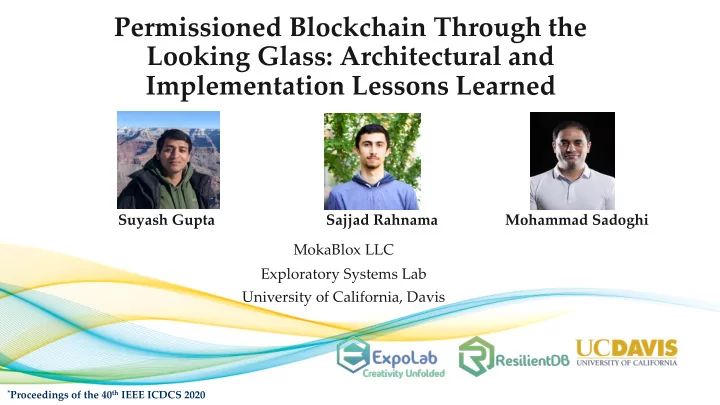

Permissioned Blockchain Through the Looking Glass: Architectural and Implementation Lessons Learned Suyash Gupta Sajjad Rahnama Mohammad Sadoghi MokaBlox LLC Exploratory Systems Lab University of California, Davis * Proceedings of the 40 th IEEE ICDCS 2020
What is Blockchain? • A linked list of blocks. • Each block contains hash of the previous block. • A block contains information about some client transactions. w N e c k l o B Previous Hash Previous Previous Genesis Hash Hash Data Data Data Client Transactions 2
Components of a Blockchain System • Replicas Store all the data. à • Client Sends transactions to process. à • Consensus Protocol à Helps ordering transactions. • Cryptographic Constructs à Authenticate replicas and clients. • Ledger Records transactions. à 3
Famous Blockchain Applications? 4
Why only Cryptocurrencies? • Throughput of initial cryptocurrencies à < 10 txns/s. • Throughput of existing distributed databases à 1 million txns/s. • Low throughput acceptable in permissionless applications. • Aim: 1) Cryptocurrency that is decentralized. 2) Identities are hidden or unknown. • Result: 1) Forks in the chain. 2)Not acceptable to industries. 5
Rise of Permissioned Blockchains • Only a selected group of replicas, although untrusted can participate. • Identities of the replica known a priori. • Prevent chain forks. • Suitable for needs of an industry à JP Morgan, IBM, Oracle • Open design of Blockchain Databases. • Throughput? < 10K txns/s. • Often cited reason à Traditional BFT consensus protocols are expensive! 6
At the core of any Blockchain application is a Byzantine Fault-Tolerant (BFT) consensus protocol. Client Crashed Primary Malicious 7
Can a well-crafted system based on a classical BFT protocol outperform a modern protocol? ResilientDB employs three-phase (of which two require quadratic communication) PBFT protocol and scales better than protocol-centric permissioned blockchain system that uses single linear-phase Zyzzyva. 8
Existing Permissioned Blockchain systems overlook system design! ResilientDB adopts well-researched database and system practices. 9 Visit at: https://resilientdb.com/
Dissecting existing Permissioned Blockchain 1) Single-threaded Monolithic Design 2) Successive Phases of Consensus 3) Integrated Ordering and Execution 4) Strict Ordering 5) Off-Chain Memory Management 6) Expensive Cryptographic Practices 10
ResilientDB Architecture SECURE EXECUTION LAYER LAYER THREADS SIGNING NET WORK QUEUES TOOLKIT BFT CONSENSUS HASHING TOOLKIT STORAGE LAYER METADATA BLOCKCHAIN 11
Multi-Threaded Deep Pipeline at Replicas Network Network Client Batch Creation Requests Input Output Message from Prepare Message to Worker Clients and Replicas & Commit Replicas and Clients Execute Checkpoint 12
Evaluation and Analysis • We ask eleven distinct questions that affect performance of a Permissioned Blockchain. • Workload provided by Yahoo Cloud Serving Benchmark (YCSB). • PBFT to achieve BFT consensus among replicas. • General Setup (unless stated otherwise): • 8-core Intel Xeon Cascade Lake CPU. Requests sent by 80K clients deployed on 4 machines. • • Employed batching à Batch size set at 100. • At each replica à one worker-thread, one execute-thread and two batch-threads 13
Insight 1: Multi-Threaded pipeline Gains Parallelizing and Pipelining tasks across worker, execution (E) and batch-threads (B). 14
Insight 1: Multi-Threaded pipeline Gains Parallelizing and Pipelining tasks across worker, execution (E) and batch-threads (B). 15
Insight 1: Multi-Threaded pipeline Gains Parallelizing and Pipelining tasks across worker, execution (E) and batch-threads (B). 16
Insight 1: Multi-Threaded pipeline Gains Parallelizing and Pipelining tasks across worker, execution (E) and batch-threads (B). 17
Insight 2: Optimal Batching Gains More transactions batched together à increase in throughput à reduced phases of consensus. 18
Insight 3: Memory Storage Gains In-memory blockchain storage à reduces access cost. 19
Insight 4: Number of Clients Too many clients à increases average latency. 20
Conclusions and Final Remarks • There are several factors that affect throughput of a blockchain system. • Fast consensus does not always implies an efficient blockchain system. • We show that a well-crafted system-centric permissioned blockchain system can outperform a protocol-centric blockchain system. • System designers need to dissect their application to find performance bottlenecks. 21
Thank You
Recommend
More recommend